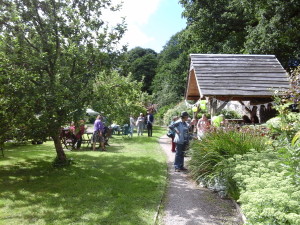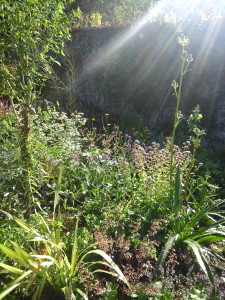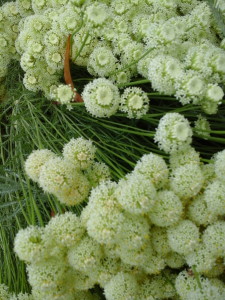Well it’s been a hectic summer in the garden. The strange combination of heat and then heavy rain has given us a recurring cycle of rapid soft growth which then flops when it is rained upon. We have already gone through over 400m of string and we are still running out of canes. Despite a winter of lifting plants which were too close to the paths and seriously hacking back growth we are still in the situation of spending far too much time in path clearing every week. Another winter of being ruthless in the garden looms!
It’s still been relatively cool many nights too, which has led to a marked difference in the growth we would expect in plants, for example the Nasturtiums in the Potager have almost completely out-competed the English Marigolds and yet the Cosmos have literally just started to open, this the third week in August.
However, we were blessed with good weather for the NGS Day and the evening ‘Berries and Bubbles’ event which followed it. Thankyou to everyone who worked hard to make these events happen. In August we also held a Mad Hatters Tea Party and Herb Propagation Workshop both as a closed event for a DASH Special Needs Group and as a late afternoon open to all event. If there is an event / workshop you would like to see us hold in the garden please get in touch.

Harvey the Rabbit visited from the Pooka Shope and Gallery in Cardigan

NGS day visitors enjoying lovely refreshments provided by fellow childrens charity Ty Hafan
A yearly difficulty in our Walled Garden is that the flowering period of plants can be shortened by the heat and conditions it creates, what I like to call the ‘Walled Garden Effect.’ As our garden is also a frost pocket we have a growing pattern of late growth which sometimes goes on later than you would expect, eg; Runner Beans, or it means that flowers don’t last as long as you would like them to. So we are constantly trialling new plants which we hope will either flower for longer and can tolerate these condition or which simply begin flowering later and will extend the season’s interest. We planted some Rudbeckia ‘Herbstsonne’ a tall yellow daisy under the Walnut tree amongst the grasses which have only just started flowering, so I am hopeful that these will prove an asset to the garden and we also planted several different Asters last year which look like they will do as we had hoped and will follow on from the many different Phloxes we planted the year before. Persicarias also thrive in our garden and the large drift of white Persicaria amplexicaulis ‘Alba’ is looking great round the pond now. A trial of a favourite plant of mine Tricyrtis aka Toad Lilies ( which are also late flowering) has found them one border which they seem to be happy in, so we hope to add to the small clump in here we now have. Look out for their delicate spotted mauve-purple flowers and equally spotted leaves. I would also love to add more hardy geraniums for their ability to flower over a long period of time and sprawl into the gaps between other perennials really tying a border together.

The old redcurrant bed on the terrace is looking lovely in the morning light in it’s first summer after re-planting
There are still plenty of borders in the garden which are either a work in progress, such as the damp, north facing border running down the left hand side that are starting to improve and areas which still need re-development such as the big patches of Phlomis ruselliana or Jerusalem Sage up on the terrace. My usual summer holiday tour of gardens has given me some ideas of changes we could make to these areas, however time and money are our limiting factors as they are with many gardeners!

This combination of Eryngium and Crocosmiia proved popular with visitors on the Terrace beds with many families being photographed with it as a backdrop.
At this time of year 3 main things are occupying us in the garden – harvesting the vegetables, removing self-set perennials to clear space for other plants to bloom and also to prevent them seeding too much eg; Evening Primrose and lastly summer pruning of our fruit trees. Many of the fruit trees have not benefitted from enough formative pruning or have perhaps been on a less dwarfing rootstock than we thought. So I am trying to prune some of the ones which are closer to the paths around the potager very hard and imagine they are very overgrown stepovers! Otherwise we may have to look at replacement in the future.

Santolina chamaecyparissus ‘Lemon Queen’ on the terrace.
It is easy to forget the intricate detail nature creates as it gets lost in the bigger picture of the borders, take the time to look at each plant and how each flowering display is created the next time you visit us.


